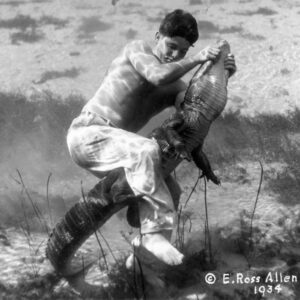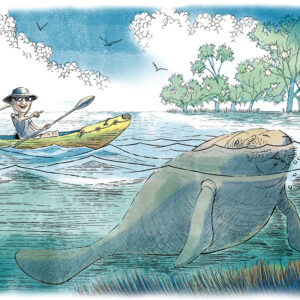Lions and tigers and bears (and elephants, too), oh my.
If you’re looking to make a wild connection, then a trio of area facilities will help bring out your inner Tarzan or Jane. And along the way, you’ll learn about many exotic species and how they came to make their home in the Sunshine State.
Elephant Encounter
Two Tails Ranch
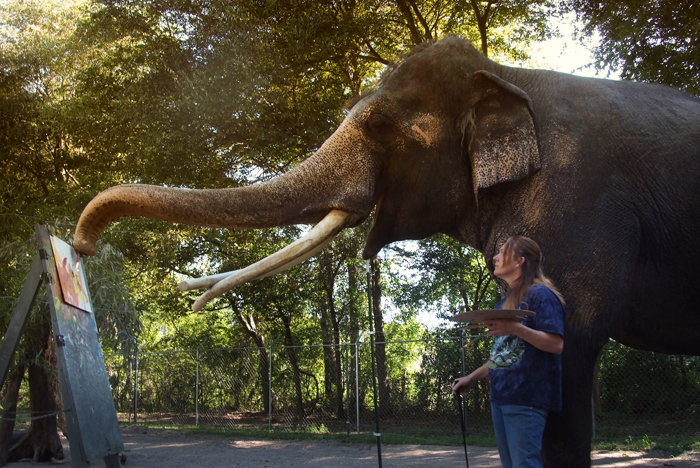
North Central Florida is well known for its cattle ranches and Thoroughbred farms. But it can also claim the distinction of having Two Tails Ranch, the only privately owned elephant facility of its kind in the United States. Located just north of Williston, the late Theodore Svertesky founded Two Tails Ranch in 1984 with Patricia Zerbini joining him in 1985. The ranch was originally established as an elephant boarding facility for those who needed a temporary or permanent place to stay. Two Tails Ranch continues that function and was opened to the public in 2009.
Today, the 67-acre ranch is home to seven Asian elephants, including one male and six females. Zerbini inherited four elephants and bought three others; all were born in captivity. In addition, the ranch’s menagerie includes two zebras, four lemurs, a camel, an ostrich, an emu and two tortoises. A 501(c)(3) non-profit organization, Two Tails Ranch is licensed by the USDA and the Florida Fish and Wildlife Conservation Commission. It is also accredited by the U.S. Zoological Association and the Zoological Association of America.
“Our mission at Two Tails Ranch is to instill awareness and educate people about elephants in captivity and in the wild,” says Zerbini, who is the ninth generation of her family to work with exotic animals. “Asian elephants are endangered, and African elephants are considered vulnerable. Loss of habitat and poaching are the two main causes of the declines in population. There needs to be more conservation action taken before it’s too late.”
Zerbini, who has worked with elephants on three different continents, is doing her part by giving people an opportunity for elephant encounters. The theory being we care about what we know about. There are guided tours at the ranch six days a week. Zerbini also established All About Elephants, an educational program for private citizens, schools, groups and professionals to gain a more comprehensive working knowledge of the pachyderms and conservation efforts.
On a beautiful, sunny afternoon, two dozen guests, including area residents and out-of-state visitors, have gathered in the bleachers just outside one of the elephant enclosures. Zerbini gives her introduction talk to the audience, but Luke is clearly the center of attention. Standing just behind Zerbini, the massive 12,000-pound Asian elephant with the large crossed ivory tusks is difficult to overlook.
“I’ve had Luke since he was 2. He’s 32 now,” says Zerbini. When a guest asks why his tusks are crossed, she answers, “Asian elephants are direct descendants of wooly mammoths, and they’ve retained that distinct characteristic.”
Zerbini then demonstrates the bond that she and Luke have by gently asking him to bow and then lie down with subtle hand gestures and body language. She points out that “elephants rarely lie down for extended periods because their enormous weight would crush their organs.”
Then it’s time for Luke to show off his artistic side. Zerbini brings in a large blank canvas on an easel and puts it in front of Luke. She holds the palette, rolls the paint brush in a color and then gives it to Luke. Holding the brush with his trunk, Luke moves to the easel and proceeds to paint. When apparently satisfied with that part of the painting, he backs up and gives Zerbini the brush. She reapplies paint and the process continues. The guests are delighted as they watch Luke’s bright, multicolored painting, decidedly Impressionistic, come to be and give the finished artwork an appreciative round of applause. Luke bows in response.
Following the initial educational portion of the basic tour, guests can pay extra for a picture with Luke, to feed one of the other elephants, take an elephant ride or have an extreme encounter with the elephants.
“I’ve loved elephants all my life,” says Zerbini. “I want to continue to share them with others with hopes that education will allow us to have elephants for generations to come.”
Two Tails Ranch
allaboutelephants.com
(352) 528-6585 or (352) 359-6676
Tours by appointment only, closed Thursdays
$20 adults, $10 kids (9 and under)
Photo with Luke: $25 • Hand feed elephant: $5
Elephant ride: $40 • Extreme encounter: $200
Big Cat Country
E.A.R.S.
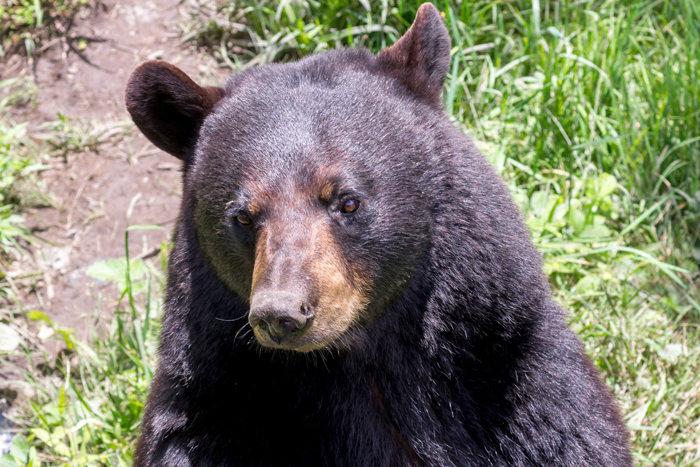
Named after a Norse Viking god, Odin is no ordinary big cat. A giant tawny beast with chocolate freckles on his head and faint stripes on his legs, Odin is a liger, a cross between a lion and a tiger. And at 1,000 pounds and still growing, he is literally the biggest cat among the big cats at the Endangered Animal Rescue Sanctuary. Odin shares his enclosure with Tamari, a Bengal tiger, and they have been pals since they were cubs. The two, estimated to be about 5 years old, were born in captivity at a breeding facility in Myrtle Beach, South Carolina. They came to E.A.R.S. when that facility closed.
Like Odin and Tamari, the other big cats and assorted wildlife have all found their way to E.A.R.S. via various routes. Many came from closed zoos and roadside tourist attractions, including one in an 18-wheeler that would literally pull over, open the doors and sell tickets for passing motorists to stop and see the animals. Then there’s those individuals who bought a tiger or a bear cub or a monkey as a pet, only to discover these animals were never meant to be pets.
“What we offer these animals who come to us is a final permanent home,” says Gail Bowen, who founded E.A.R.S. and has studied tigers in Nepal, India and China. “Our purpose is preserving endangered animals with dignity and educating people about the true plight of these animals.”
Located on 30-plus wooded acres some 20 miles north of Ocala in Citra, E.A.R.S. is a 501(c)(3) non-profit organization. It is licensed by the Florida Fish and Wildlife Conservation Commission and the United States Department of Agriculture. E.A.R.S. offers $18 one-day membership tours on Wednesdays and Saturdays. The 80-minute guided walking tour on the paths that meander around the animal enclosures provide an up-close-and-personal visit. All of the big cats have daily access to large turnout areas for paws-on-the-ground time. And while there are black bears, deer and various small primates, such as macaques, marmosets, bush babies and capuchins, make no mistake about it, the big cats are the stars.
“People want to see big cats like lions, leopards and tigers,” says Bowen. “There is something special about tigers in particular that draw people to them. Unfortunately, that’s also why these animals have come to us from the situations that they have with people exploiting them. But at least now they have a good home with us.”
There are currently 25 tigers in residence at the sanctuary, all Bengals except for one Sumatran tiger. The latter is a rare tiger species that inhabits the Indonesian island of Sumatra and is considered critically endangered. There are also four blue-eyed white tigers, one of which was bred for the famed Siegfried and Roy’s Las Vegas show. One of the Bengal tigers was voluntarily donated by the Ringling Bros. and Barnum and Bailey Circus with a donation given for her care. Others came from picture-babies breeding operations; a production company that used tigers for commercials; a woman who didn’t have a wildlife license and kept a tiger in her Daytona Beach condo and often walked it on a leash on the beach; and even a Jewish rabbi who had a wildlife license, but when he died, his widow could no longer care for the tiger.
“I’ve loved tigers and have been involved with them for 50 years,” says Bowen. “I understand why people want to see them. They are magnificent creatures. And while all our tigers were born in captivity, they are still wild animals, and we treat them as such.”
Also in residence are two leopards, who are brothers, and two lions, a male and a female. All four came to E.A.R.S. when a Reno, Nevada, zoo closed down. There is no breeding at the sanctuary, and all the animals are neutered once they arrive.
“All the animals who come here have a story,” says Bowen. “What we do is give them a forever home and a happy ending to their story.”
Endangered Animal Rescue Sanctuary
- earsinc.net or (352) 454-6454
- facebook.com/earssanctuary
- One-day membership tours on Wednesdays & Saturdays, 1:45-3:15pm
- $18 adults 13 & up, $10 kids 3-12, kids 2 and under free
- Cash & checks only, all tours scheduled in advance
- For volunteer opportunities, call Andy at (203) 232-4397.
E.A.R.S. Annual Spring Fundraiser
Hot Cars & Cool Cats Spring Car Show
- Saturday, April 22, 10am-3pm
- 2250 NE 70th Street (Hwy 326)
- Meet Siberian tiger Maximus, facebook.com/thetigermaximus
- Maximus, the E.A.R.S. official mascot, will be celebrating his first birthday.
- Free to the public, $10 to enter car or motorcycle into the show
- For more information, contact Sue Nassivera at (352) 266-2859.
A Safe Haven
Forest Animal Rescue
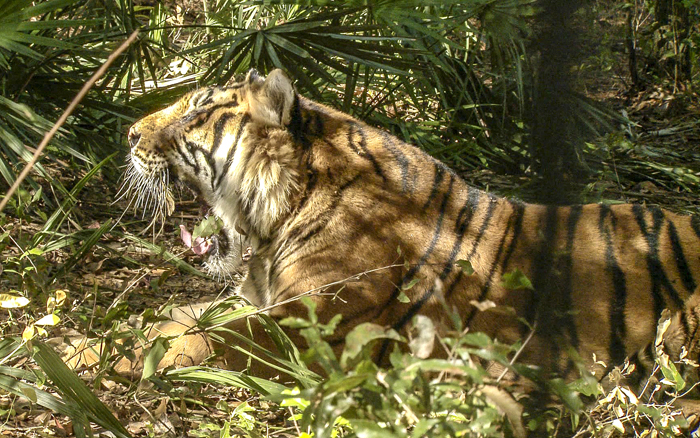
When their reclusive owner died, tigers Tony and Roy were found living in 10×10 dog kennels in a Texas backyard. No one knew where they had originally come from or how long they had lived in that backyard. But both were emaciated, weighing slightly more than half of what should have been their normal adult male tiger weight of 550 to 600 pounds.
But luckily and happily for Tony and Roy, suspected to be Bengal tiger hybrids, today they are thriving at Forest Animal Rescue (FAR). The brothers share two 1-acre habitats with four female adult tigers, who were rescued from a Colorado facility that bred cubs for photo shoots.
Tucked away on 80 very secluded acres in the Ocala National Forest, FAR provides a sanctuary home to more than 100 wild animals who, like Tony and Roy, have been exploited in some way by people. Resident animals include lemurs, African servals, spider and capuchin monkeys, gray wolves, black bears, bats and tortoises. Many were part of roadside tourist-attraction zoos; others were bought to be pets.
“Many of the animals that come to us were bought illegally as babies or adults,” says Lisa Stoner, who co-founded the sanctuary with her husband, Kurt Stoner. “People put them on display and charged people to look at them or have some interaction with them. Other people put them in their bathrooms, in dog kennels, in their garages. They had no idea how to care for them. And soon they find out that an African serval or a capuchin monkey or a black bear isn’t going to be a good pet. When they come here, it is the best quality of life that these animals have ever had in their lives.”
The Stoners are not newcomers to operating a sanctuary. In 1998, they established Peace River Refuge & Ranch in South Florida. As development increasingly encroached, they began looking for new land to move the sanctuary to. In 2010, they bought raw woodlands property in the Ocala National Forest and relocated in 2013. Appropriately enough, the new sanctuary was named Forest Animal Rescue. In addition to providing a forever home, FAR also rehabs and releases American black bears.
A 501(c)(3) non-profit organization, FAR is licensed by the United States Department of Agriculture, U. S. Fish and Wildlife Service, Florida Fish and Wildlife Conservation Commission and the Centers for Disease Control and Prevention. FAR is also accredited by the American Sanctuary Association and Tigers In America. FAR is supported entirely by private donations from individuals, groups and foundations.
“We take being a sanctuary very seriously. The animal’s welfare is our top priority,” says Lisa. “We are not a zoo or a breeding operation. All our animals are given appropriate as possible natural habitats, healthy diets and excellent veterinary care when needed. All our animals are spayed/neutered and micro-chipped. They are given the opportunity to live out their natural lives with dignity and not as victims.”
True to that mission, FAR only offers public tours twice a month for $50 per person. Guests are driven around the sanctuary in a Land Rover for a close-up look at the animals in the natural habitats.
“Limiting the frequency and using a vehicle the animals are familiar with is the most stress-free option we can provide,” says Lisa.
On a drive through the sanctuary, the animals do indeed come out to greet the familiar Land Rover. Guests are afforded a unique, non-intrusive look at the animals’ lives, close enough to hear Tony’s signature tiger chuffing. Proof indeed that he is a happy tiger at Forest Animal Rescue.
Forest Animal Rescue
- forestanimalrescue.org
- facebook.com/forestanimalrescue
- (352) 625-7377
- Volunteer/internship opportunities available
- Tours two times a month by appointment
- $50 per person

